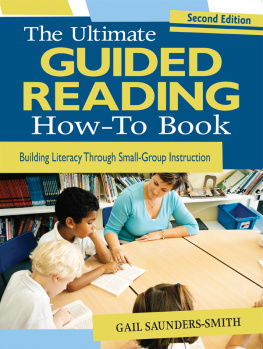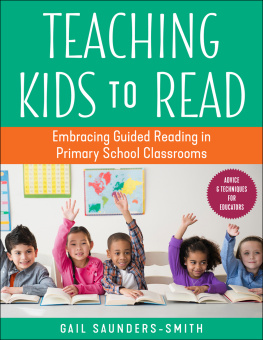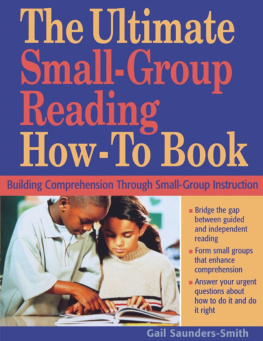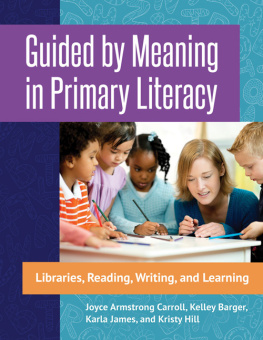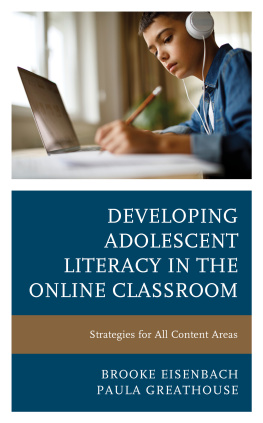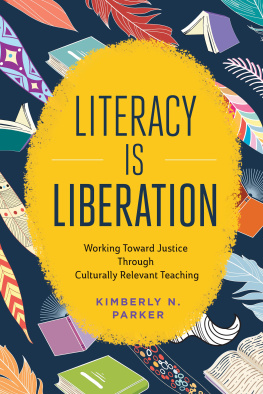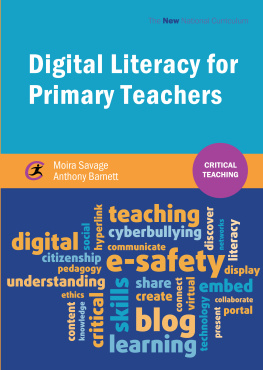Gail Saunders-Smith - The Ultimate Guided Reading How-To Book: Building Literacy Through Small-Group Instruction
Here you can read online Gail Saunders-Smith - The Ultimate Guided Reading How-To Book: Building Literacy Through Small-Group Instruction full text of the book (entire story) in english for free. Download pdf and epub, get meaning, cover and reviews about this ebook. year: 2015, publisher: Skyhorse, genre: Children. Description of the work, (preface) as well as reviews are available. Best literature library LitArk.com created for fans of good reading and offers a wide selection of genres:
Romance novel
Science fiction
Adventure
Detective
Science
History
Home and family
Prose
Art
Politics
Computer
Non-fiction
Religion
Business
Children
Humor
Choose a favorite category and find really read worthwhile books. Enjoy immersion in the world of imagination, feel the emotions of the characters or learn something new for yourself, make an fascinating discovery.
- Book:The Ultimate Guided Reading How-To Book: Building Literacy Through Small-Group Instruction
- Author:
- Publisher:Skyhorse
- Genre:
- Year:2015
- Rating:3 / 5
- Favourites:Add to favourites
- Your mark:
- 60
- 1
- 2
- 3
- 4
- 5
The Ultimate Guided Reading How-To Book: Building Literacy Through Small-Group Instruction: summary, description and annotation
We offer to read an annotation, description, summary or preface (depends on what the author of the book "The Ultimate Guided Reading How-To Book: Building Literacy Through Small-Group Instruction" wrote himself). If you haven't found the necessary information about the book — write in the comments, we will try to find it.
The Ultimate Guided Reading How-To Book: Building Literacy Through Small-Group Instruction — read online for free the complete book (whole text) full work
Below is the text of the book, divided by pages. System saving the place of the last page read, allows you to conveniently read the book "The Ultimate Guided Reading How-To Book: Building Literacy Through Small-Group Instruction" online for free, without having to search again every time where you left off. Put a bookmark, and you can go to the page where you finished reading at any time.
Font size:
Interval:
Bookmark:


Copyright 2009 by Gail Saunders-Smith.
First Skyhorse Publishing edition 2015.
All rights reserved. No part of this book may be reproduced in any manner without the express written consent of the publisher, except in the case of brief excerpts in critical reviews or articles. All inquiries should be addressed to Skyhorse Publishing, 307 West 36th Street, 11th Floor, New York, NY 10018.
Skyhorse Publishing books may be purchased in bulk at special discounts for sales promotion, corporate gifts, fund-raising, or educational purposes. Special editions can also be created to specifications. For details, contact the Special Sales Department, Skyhorse Publishing, 307 West 36th Street, 11th Floor, New York, NY 10018 or .
Skyhorse and Skyhorse Publishing are registered trademarks of Skyhorse Publishing, Inc., a Delaware corporation.
Visit our website at www.skyhorsepublishing.com.
10 9 8 7 6 5 4 3 2 1
Library of Congress Cataloging-in-Publication Data is available on file.
Cover design by Karine Hovsepian
Print ISBN: 978-1-63450-366-2
Ebook ISBN: 978-1-5107-0132-8
Contents
Acknowledgments
A s humans, we learn from each other. That was the first sentence in the first edition of this book, and it remains the first sentence in this edition because it is true. The older I get, the truer the phrase lifelong learner becomes. Just when we think we know it all, something else comes along to shift our understanding. I guess thats why the species has continuedyou learn something new every day. As with the first edition, this book represents what I have continued to learn from other people. Now is my chance to say thank you for all that you have helped me learn.
This book could not have been written without administrators, teachers, and colleagues who invited me into their districts and classrooms and who welcomed me into their conversations. Thanks continue to go to all those who made the first edition possible and to those who continued my learning, including: Debbie Hagg of Youngstown City Schools; Kathie Carlile and the teachers and children at E. J. Blott Elementary in Liberty, Ohio; the teachers and children in Hudson, Ohio schools; and the teachers and children at Kleckner Elementary in Green, Ohio. I thank the undergraduates in the Early Childhood Department at the Beeghly College of Education at Youngstown State University for giving me reason to rethink everything I thought I knew. I thank the following people who have been instrumental in continuing the path that has become my professional life: Phil Ginnetti, Mary Lou DiPillo, Dora Bailey, Gay Su Pinnell, and Marie Clay.
Sincere thanks for kind encouragement, knowledgable guidance, and enduring patience go to Susan Jarvis, Joanna Coelho, Amy Schroller, and Jessica Alan at Corwin.
Heartfelt thanks go to the memories of my mother and father, Ruth and John Saunders, who together made reading and writing a natural, integral part of our lives; and to the memory of my husband, Chuck Smith, who took care of everyone and everything. Thank you, thank you, thank you!
Without each of you, what is would not be.
Additionally, Corwin would like to acknowledge the following peer reviewer for her editorial insight and guidance:
Deb Bible, NBCT
Literacy Teacher and Consultant
Dundee Highlands School
West Dundee, IL
About the Author
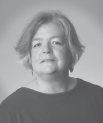 Gail Saunders-Smith is an assistant professor of literacy in the Beeghly College of Education at Youngstown State University. She is a former primary-level classroom teacher and Reading Recovery teacher leader. She continued to work with children and teachers when she served eight school districts as Reading/Language Arts K12 Supervisor and Coordinator of State and Federal Programs and as independent national staff developer. Much in demand as a lively and well-informed presenter, she has given workshops across the United States and Canada on all aspects of literacy development. Gail has visited schools in Great Britain, New Zealand, Australia, and Russia.
Gail Saunders-Smith is an assistant professor of literacy in the Beeghly College of Education at Youngstown State University. She is a former primary-level classroom teacher and Reading Recovery teacher leader. She continued to work with children and teachers when she served eight school districts as Reading/Language Arts K12 Supervisor and Coordinator of State and Federal Programs and as independent national staff developer. Much in demand as a lively and well-informed presenter, she has given workshops across the United States and Canada on all aspects of literacy development. Gail has visited schools in Great Britain, New Zealand, Australia, and Russia.
Gail has published a number of teacher support materials. She has also published more than 46 nonfiction little books and five big books for emergent readers, including selections that are part of the Pair-It Books series and others as part of the Pebble Books series. Gail is a consulting editor for Red Brick Learning, an imprint of Capstone Press. In addition, she has published articles on early literacy development in a number of journals.
Gail holds a BS and an MA in early childhood education, an MS in administration and supervision, and a PhD in early literacy development. She describes herself as a reader, writer, teacher, and student.
Introduction

S o, whats new? Well, as an educational society, we now have scientific evidencethanks to the neuroscientiststhat new knowledge does attach to existing knowledge: Vygotsky was right! We are realizing more and more that as the planet continues to shrink, educators have a responsibility to differentiate more than ever before. The need to differentiate has pervaded cultural (including language, religion, traditions, and beliefs), cognitive, physical, psychosocial, and other aspects of classroom life. This edition attempts to address the constructivist nature of learning and the increasing need to differentiate. This edition represents the continued thinking about and working with children in learning how to read. Experience shapes and reshapes what we once thought we knew. The changes in my understandings, my increased awareness and understanding, are documented here. The book remains a practitioners guide to teaching children how to read.
What is the same? Well, we continue to read and to teach children to read. Educatorsmost of us, anywayread everything from professional books and journals to those quality trashy novels. Ah, the trashy novel. The question remains the same: How did we get this way? What happened that made us such consumers of print? More important, how do we help our students to become such readers?
HOW IT HAPPENED
The Introduction to the first edition of this book invited you, the reader, to think back to how you learned to read. How old were you? Was it in school or out of school? Who was involved? What kinds of things do you remember reading? How did you feel about reading and being a reader? Was it pleasant or frustrating?
I admitted that I could not remember exactly how or at what point reading began for me. I shared a few stories of reading at home, being read to as a child, and just sort of learning how to read without being taught to read. As I look back on this now, I realize that my brother and I lived in an environment where reading happened all around us, all the time. I suppose you could say he and I were immersed in a literate environment. We saw reading happening as we watched our parents read newspapers and books. We were read to in the evenings before bed and on the front porch in the summer. We got books from the library every Saturday and read them over and over again, whether we could read them or not. I suppose it is true: you learn what you live, and we lived reading. No wonder we learned to read before we were taught to read.
Font size:
Interval:
Bookmark:
Similar books «The Ultimate Guided Reading How-To Book: Building Literacy Through Small-Group Instruction»
Look at similar books to The Ultimate Guided Reading How-To Book: Building Literacy Through Small-Group Instruction. We have selected literature similar in name and meaning in the hope of providing readers with more options to find new, interesting, not yet read works.
Discussion, reviews of the book The Ultimate Guided Reading How-To Book: Building Literacy Through Small-Group Instruction and just readers' own opinions. Leave your comments, write what you think about the work, its meaning or the main characters. Specify what exactly you liked and what you didn't like, and why you think so.

